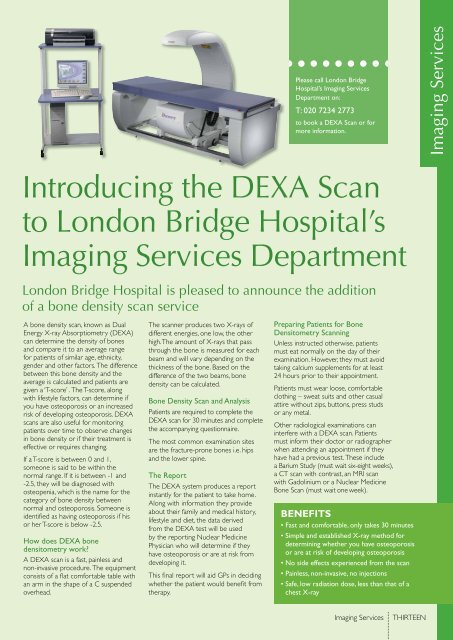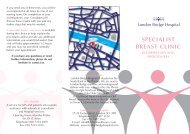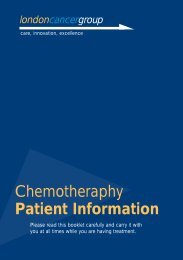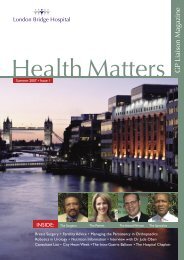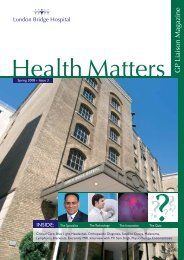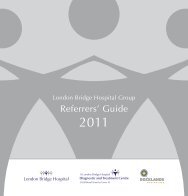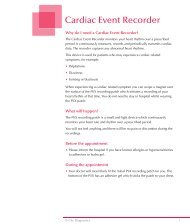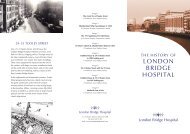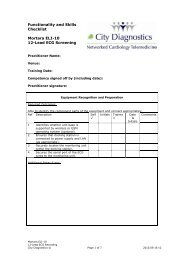Health Matters - London Bridge Hospital
Health Matters - London Bridge Hospital
Health Matters - London Bridge Hospital
- No tags were found...
Create successful ePaper yourself
Turn your PDF publications into a flip-book with our unique Google optimized e-Paper software.
Please call <strong>London</strong> <strong>Bridge</strong><strong>Hospital</strong>’s Imaging ServicesDepartment on:T: 020 7234 2773to book a DEXA Scan or formore information.Imaging ServicesIntroducing the DEXA Scanto <strong>London</strong> <strong>Bridge</strong> <strong>Hospital</strong>’sImaging Services Department<strong>London</strong> <strong>Bridge</strong> <strong>Hospital</strong> is pleased to announce the additionof a bone density scan serviceA bone density scan, known as DualEnergy X-ray Absorptiometry (DEXA)can determine the density of bonesand compare it to an average rangefor patients of similar age, ethnicity,gender and other factors. The differencebetween this bone density and theaverage is calculated and patients aregiven a ‘T-score’ . The T-score, alongwith lifestyle factors, can determine ifyou have osteoporosis or an increasedrisk of developing osteoporosis. DEXAscans are also useful for monitoringpatients over time to observe changesin bone density or if their treatment iseffective or requires changing.If a T-score is between 0 and 1,someone is said to be within thenormal range. If it is between -1 and-2.5, they will be diagnosed withosteopenia, which is the name for thecategory of bone density betweennormal and osteoporosis. Someone isidentifi ed as having osteoporosis if hisor her T-score is below -2.5.How does DEXA bonedensitometry work?A DEXA scan is a fast, painless andnon-invasive procedure. The equipmentconsists of a fl at comfortable table withan arm in the shape of a C suspendedoverhead.The scanner produces two X-rays ofdifferent energies, one low, the otherhigh. The amount of X-rays that passthrough the bone is measured for eachbeam and will vary depending on thethickness of the bone. Based on thedifference of the two beams, bonedensity can be calculated.Bone Density Scan and AnalysisPatients are required to complete theDEXA scan for 30 minutes and completethe accompanying questionnaire.The most common examination sitesare the fracture-prone bones i.e. hipsand the lower spine.The ReportThe DEXA system produces a reportinstantly for the patient to take home.Along with information they provideabout their family and medical history,lifestyle and diet, the data derivedfrom the DEXA test will be usedby the reporting Nuclear MedicinePhysician who will determine if theyhave osteoporosis or are at risk fromdeveloping it.This fi nal report will aid GPs in decidingwhether the patient would benefi t fromtherapy.Preparing Patients for BoneDensitometry ScanningUnless instructed otherwise, patientsmust eat normally on the day of theirexamination. However, they must avoidtaking calcium supplements for at least24 hours prior to their appointment.Patients must wear loose, comfortableclothing – sweat suits and other casualattire without zips, buttons, press studsor any metal.Other radiological examinations caninterfere with a DEXA scan. Patientsmust inform their doctor or radiographerwhen attending an appointment if theyhave had a previous test. These includea Barium Study (must wait six-eight weeks),a CT scan with contrast, an MRI scanwith Gadolinium or a Nuclear MedicineBone Scan (must wait one week).BENEFITS• Fast and comfortable, only takes 30 minutes• Simple and established X-ray method fordetermining whether you have osteoporosisor are at risk of developing osteoporosis• No side effects experienced from the scan• Painless, non-invasive, no injections• Safe, low radiation dose, less than that of achest X-rayImaging ServicesTHIRTEEN


